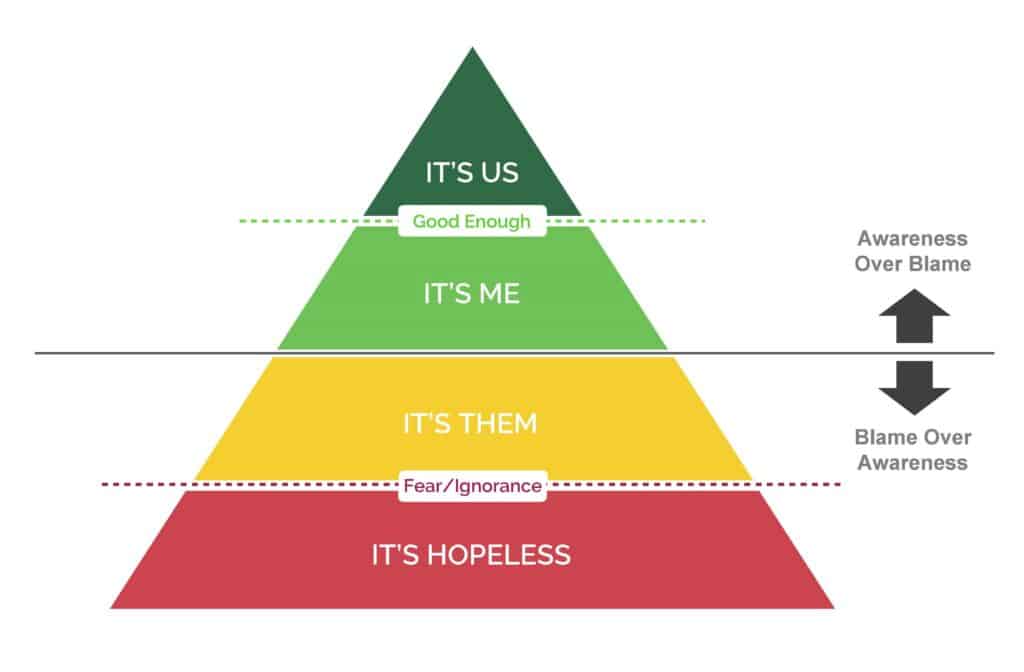At The Roundtable, clients come to us when they recognize there’s a gap between where they are and where they want to be. They are looking for something more.
Increased performance. Stronger leadership. A better culture.
“More” is meaningless however in the absence of knowing your starting point.Our first step in determining how we can best support clients in pursuit of their goals is to help them understand where their organization sits relative to the blame-awareness threshold.
Our experience has helped us identify a hierarchy of organizational mindsets which directly correlate with an organization’s performance – measured both by the bottom line and cultural health of the organization.
If you’ve worked in more than one organization in your career, you may have also noticed the impact that organizational mindset has on your performance and those around you. Let’s look at each of these performance “zones” and see what helps us move from struggling to excelling.
The Blame Game
At the baseline zone, we see organizations with a prevailing mindset of hopelessness. In these organizations, leaders feel disempowered to effect any change, are checked out and simply dialing it in to collect their paycheck. We see dysfunctional teams, who half-heartedly pursue targets that are never fully realized. Organizations in this “red zone” are not optimizing the potential of even their highest performers, and company lore tells the tale of a culture that will never change.
To move beyond this state of hopelessness, leaders need to hold a fundamental belief that better is possible. When leaders begin to believe that they can affect change, we begin to shift to possibility.
Crossing the Threshold
As leaders begin to recognize that things can get better, the prevailing mindset becomes one of “if only.”
Targets would be realized, performance would improve, our culture would be fantastic, if only…
If only this person would perform better.
If only this team would work harder.
If only these people would get their acts together.
If only.
Tragically, hoping for others to shift their behaviour is a fool’s errand. To shift from a culture of blame to a culture of awareness requires leaders to lean into the question “what part of this do I own?”
It’s through taking accountability that leaders, teams, and organizations can cross the threshold and put awareness over blame.
From Blame to Accountability
The blame-awareness threshold is evident when leaders begin to double down on building their self-awareness. The more that individual leaders start to recognize what part of the challenges they can impact, the more able they are to fix the problems that have been identified. These leaders recognize that change starts with them. They go above and beyond…performing at heroic levels to make an impact and bring in results. Team performance improves thanks to the contributions of the top 20% and the company culture shifts from ‘words on a wall’ to something that people begin to look to leaders to uphold.
For many organizations, this feels like the golden ticket. We have self-aware leaders and have identified those that have the potential to drive performance. This is often where organizations tap out with the view that this is “good enough.”
Beyond Good Enough
“Good enough” is a dangerous place to be. It causes us to get complacent and take things for granted. Settling for good enough can make you obsolete if you’re not careful.
For organizations who refuse to settle, there is a deep belief that the whole is greater than the sum of its parts. There’s a belief that the collective potential is so much more than the contributions of a few superstars. Leaders move beyond their egos to realize the potential of every individual in order to realize exponential possibilities. In our work with these organizations, we see leaders galvanizing those around them so that everyone performs at their highest levels. Where teams work collectively and don’t rely on the heroic efforts of one or two superstars to drive results. And where cultures are embodied by everyone in the organization, not only by those at the top.
The prevailing mindset is that it’s not about “me,” it’s about “us” and that we all achieve more by leaning into each other’s strengths and talents together.
What Zone is Your Company In?
Most organizations oscillate between one or two zones depending on how well the frameworks of accountability, alignment and agility are embedded.
If you’re interested in cultivating leadership cultures and teams where strengths are leveraged and collective impact is realized book a scoping call with a member of our team. We can help you identify which zone you’re in and what the right next step forward is to build a sustainable culture of engagement, performance and results.
Stay tuned for our upcoming series where we will share more on how to help your organization shift from individualist, heroic leadership to unleash collective impact.




